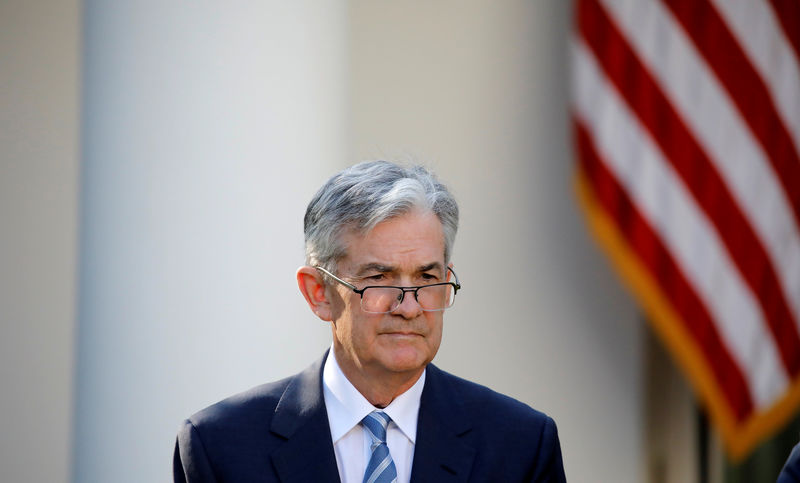(Bloomberg Opinion) -- Federal Reserve Chair Jerome Powell had a chance Wednesday to push back against both over-aggressive bond traders and Trump administration officials who were pounding the table for interest-rate cuts. He had the cover of not just a strong rebound in the U.S. labor market but also the backing of regional Fed presidents like Patrick Harker and Loretta Mester, who had already advocated this month for keeping the central bank’s lending benchmark unchanged.
Instead, in prepared remarks to U.S. lawmakers, he told the bond market and the president that a quarter-point rate cut is a sure thing at the end of the month.
Rather than highlighting the strength of the U.S. economy, Powell seemed to make every effort to note all the possible risks and where it’s falling short. Guy LeBas, chief fixed-income strategist at Janney Montgomery Scott, noted that in his description of the current economic situation and outlook, Powell wasted no time brushing off the first-half performance:
The economy performed reasonably well over the first half of 2019, and the current expansion is now in its 11th year. However, inflation has been running below the Federal Open Market Committee's (FOMC) symmetric 2 percent objective, and crosscurrents, such as trade tensions and concerns about global growth, have been weighing on economic activity and the outlook.
This is more or less a snapshot of Powell’s stance throughout the remarks. They’re far more pessimistic than expected, focusing on trade tensions and the slowing global economy and what that sort of uncertainty might mean for the U.S. “There is a risk that weak inflation will be even more persistent than we currently anticipate,” he said. That’s an abrupt change of tune. So much for those “transitory” factors subduing price growth that the Federal Open Market Committee saw just two months ago. Or that the latest reading of the consumer price index is still to come this week.
In a way, this is what markets expected all along. The odds of a quarter-point interest-rate cut have been stuck right around 100% since last week’s jobs data. But Powell’s unambiguous move toward the dovish contingent of the Fed, which thinks an “insurance cut” is necessary, is nonetheless new information. To be clear, this was not a “hint” of a July rate cut. It was a declaration.
As I wrote last week, Powell had a real opportunity with this testimony to shake bond traders from their 100% conviction. In fact, he was probably the only Fed member who could do it. My Bloomberg Opinion colleague Conor Sen and I recently discussed this idea of what it would take to break through the 100% mark, imagining this sort of conversation among two traders heading into Powell’s testimony:
Trader 1: I really don’t think the Fed will cut rates this month. I should bet on that.
Trader 2: Of course the Fed will cut. Markets have priced in a 100% chance. They’ve never disappointed in that scenario and they won’t this month either.
Trader 1: But the jobs numbers were strong, other Fed officials have signaled they’re not fully on board with a cut, inflation is still decent and stocks are at all-time highs.
Trader 2: Yes. Still, the markets have priced in a 100% chance of a cut. They’ve never disappointed in that scenario and they won’t this month either.
Trader 1: But…
Trader 2: The markets have priced in a 100% chance of a cut. They’ve never disappointed in that scenario and they won’t this month either.
Trader 1: OK, you’re right. I’ll just wait to see if the odds fall below 100% before betting.
Obviously, with those sorts of conversations on trading desks around the world, no one ends up taking the first step toward pricing out an interest-rate cut. That sort of inertia requires someone like Powell to break it. It didn’t happen, and that was by design.
It’s hard to pinpoint what precisely persuaded Powell capitulate to easing sooner rather than later. Some will probably cite his comments that “an ounce of prevention is worth a pound of cure” as evidence that he was leaning toward lowering rates in July all along. That wasn’t my read, and I wasn’t alone. Bloomberg Economics and Bank of America Corp (NYSE:BAC). were among those expecting the Fed to hold steady this month, and Citigroup Inc (NYSE:C). this week reiterated that a July interest-rate cut wasn’t a done deal.
It will be worth watching how Powell answers questions about the central bank’s independence and its ability to withstand political pressure. There’s simply no escaping the fact that the Fed is about to lower interest rates after months of President Donald Trump demanding it do so, all the while chiding policy makers for being clueless and suggesting he has the power to fire or demote Powell. This White House views the stock market as a referendum on its economic policies, and, thanks to Powell, the S&P 500 reached another record on Wednesday, eclipsing 3,000 for the first time.
The debate on lowering interest rates in July is over. Now, traders will move on to ponder whether the Fed can really do just one for insurance, or whether this is the beginning of an extended easing cycle that will once again bring U.S. yields back toward all-time lows.
